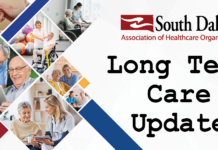Having trouble recruiting and retaining qualified workers? Susan Hildebrandt has 2 important message for you:
First, you’re not alone.
And second, help is on the way.
That help comes from the launch of LeadingAge’s new Center for Workforce Solutions. Hildebrandt, who is vice president of workforce initiatives at LeadingAge, will direct the center’s activities.
“We heard from members and we listened,” says Hildebrandt, citing a recent LeadingAge survey illustrating members’ most pressing workforce issues.
An insufficient number of qualified applicants for vacancies was cited as a top challenge by 83.7 percent of respondents to the benchmark survey. A third of respondents reported that competitive wages (65 percent) and staff turnover (63 percent) were pressing challenges.
“LeadingAge has made it a strategic priority to address these challenges,” says Hildebrandt. “I spend every hour of my working day thinking about these issues, talking to members about their concerns, and trying to help develop solutions to all these problems. LeadingAge took this member concern very seriously and we acted on it.”
Short-Term Goals
The Center for Workforce Solutions will serve as a platform for LeadingAge members and state affiliates to engage in ongoing, collaborative problem-solving around workforce issues.
The center’s work will be guided by a National Workforce Advisory Group, a representative group of LeadingAge members and state executives. A subcommittee of the advisory group will address the unique workforce challenges faced by rural providers operating in sparsely populated regions where the potential pool of workers is not adequate to meet the demand.
Beginning in June, the center will have its own home on the LeadingAge website, where it will serve as a one-stop shop for user-friendly information and resources about the aging services workforce.
Initially, the center will focus on collecting and disseminating promising practices around recruitment and retention. It also will share elements of the comprehensive workforce initiatives that are currently being undertaken by several state affiliates. The website’s collection of resources will grow over time and will eventually include model workforce policies and legislation, toolkits and training materials.
“I am really struck by how many creative and effective recruitment and retention programs exist already,” says Hildebrandt. “We’re not interested in reinventing the wheel, so if there are good ideas out there that have been shown to be effective, we want to make sure members know about them.”
Long-Term Goals
Long-term goals for the center revolve around partnerships and messaging.
The center hopes to collaborate with traditional partners, such as community colleges, as well as non-traditional partners, including businesses, to find practical solutions to workforce challenges.
“This is too big a task for LeadingAge to do alone,” says Hildebrandt. “We need to be on the lookout for potential partners that we haven’t thought of before but who might have a particular interest in issues that are important to us.”
Hildebrandt, who came to LeadingAge in late 2016 from the Patient Centered Outreach Research Institute (PCORI), is no stranger to partnerships. As PICORI’s director of stakeholder engagement, she was responsible for bringing together businesses, researchers, and policy makers to ensure that PCORI’s patient-centered research was compelling and useful.
“Basically, my goal at PCORI was to build a coalition of groups that were really invested in the organization’s success,” she says. “Now, that’s my goal at LeadingAge.”
Hildebrandt is hoping that a broad coalition of members and partners will eventually help increase the number of people working at all levels in the field of aging services. But that won’t happen without a foundational reframing of what it means to work in the field, she says.
“We need to develop messaging that portrays the aging services workforce as a valuable, valued and critical profession,” she says. “We need to demystify aging and aging services, raise awareness among nontraditional workers about careers they might pursue in the aging field, and convince prospective workers that these really are the jobs of the future.”
Preparing for the Long Haul
Hildebrandt acknowledges that workforce-related challenges are immense, but she’s confident the LeadingAge Center for Workforce Solutions can make a difference.
“We are working on these issues every day and, slowly but surely, we will be able to address this problem,” she says. “It’s not going to be an overnight fix, particularly in rural areas. But LeadingAge, to its credit, is taking action because we know our members can’t provide high-quality service and supports without high-quality people. The success of our members depends on the success of our workforce, and LeadingAge is committed to working to ensure the success of both.”







